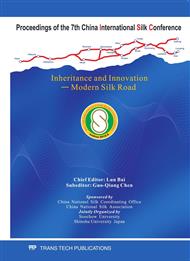p.412
p.418
p.424
p.429
p.434
p.439
p.445
p.450
p.454
The Research on Electronic Measurement of Steam with High Temperature and High Humidity in the Steaming Process
Abstract:
Because of the seldom research on temperature and humidity measurement of gas with high temperature and high humidity, workers in steaming workshops judge the temperature and humidity of steam in steamers on their subjective experience, which limits the accurate control of temperature and humidity of steam in steaming boxes. In reaction to the difficult measurement of high temperature and high humidity gas, a kind of electronic device has been developed to solve the problem. Through ingenious design of programming in assembly language and of electronic circuit, the device can automatically start an on chip heating element to prevent steam from condensing, and display the high temperature and relative humidity of steam in steamers. It will be propitious to break through the shackles of subjective experience, realize small changes in the temperature and humidity of steam in steaming boxes, and provide a basis and premise for controlling and regulating the temperature and humidity of steam. In addition, it will play an important role in gearing down the hygroscopic agent dosage, reducing the production cost, conserving energy, protecting environment and improving the quality of steaming.
Info:
Periodical:
Pages:
434-438
Citation:
Online since:
January 2011
Authors:
Keywords:
Price:
Сopyright:
© 2011 Trans Tech Publications Ltd. All Rights Reserved
Share:
Citation:


